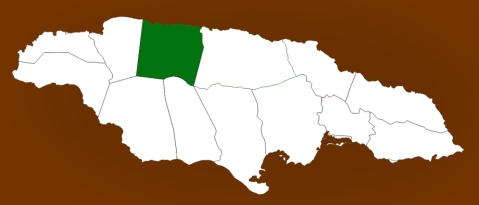Green Park Sugar Estate | The History

This is the first of two blog posts on the TheLastGreatGreatHouseBlog.wordpress.com. The first post will discuss the history of the estate and second post will discuss the great house itself. Much of the information is derived from the excellent research by Brett Ashmeade-Hawkins into the estate.
Green Park Estate was located approximately ten kilometers from Falmouth in Trelawny Parish. A portion of it was originally the Bradshaw Estate, named after James Bradshaw. Oliver Cromwell, Lord Protector of England granted to it to James Bradshaw in 1655 for the part his Father or Uncle (it is uncertain) John Bradshaw played in signing the death warrant of King Charles I. In 1660, King Charles II granted an adjacent estate to Richard Barrett and in 1706, Queen Anne granted 248 acres to Francis Egg who sold it to George Collier who renamed it Green Pond. George Sinclair bought the property from George Collier in 1740 and then built the first great house. In 1743, he sold it to William Clarke who built the second great house on the property, which was now 300 acres. He used is as a cattle operation. In 1759, Clarke sold the property to Edward Barrett who had inherited the Barnett Estate, increasing the property size to 742 acres. In 1759, Edward Barrett sold the property to James Peterkin who resold it to two Kingston merchants named John Kennion and Thomas Southworth in 1761. Thomas Southworth moved to the plantation, changed the name to Green Park and changed it from a cattle operation to sugar estate. Construction began on the present great house in 1764 by Thomas Southworth but he died before it was completed. William Atherton, Southworth’s heir, moved to the estate, took over the operation and completed the great house between 1768 and 1769.
During the 1770s, William Atherton expanded the estate by purchasing the adjoining Bradshaw Estate in 1771, which increased the size to 1,315 acres, and he added a second sugar mill in 1773 with an imposing stone windmill, which supplemented the mill powered by cattle. He imported hundreds of slaves from Africa to work in the cane fields and sugar factories of what was now the third largest estate of the eighty-eight estates in Trelawny Parish. William Atherton established himself, not only as one of the wealthiest sugar planters but also established himself as a merchant in the nearby towns of Martha Brae and Falmouth. Additionally he acted as the attorney for William Gale who owned the Gale Valley estate and Edward Hyde who owned the Swanswick Estate as well as several other planter families. (I will report on the existing Gales Valley and Swanswick great houses in a later blog. He also owned the Spring Valley Pen, which I will report on, in a later blog.) This made him an immense fortune and allowed him to purchase Prescott Hall, a country estate near Preston in Lancashire and retire to England in 1783. He died in 1803 and left the Green Park Estate to his nephew, John Atherton.
In 1810, the plantation records listed the estate having 550 slaves and 302 head of cattle. Green Park Estate stayed in the family until 1910, when the family decided to sell it to their Planting-Attorney, Walter Woolliscroft who had managed the estate for many years. In 1920, Mr. Woolliscroft made a fortune in the “Dance of the Millions.” In 1919, sugar sold for US$0.05 per pound:
1919 Average- US$0.05
January 1920- US$0.06 1/2
February 1920- US$0.095-the highest sugar had ever sold
March 2- US$0.10
March 18- US$0.11
March 27- US$0.12
April 8- US$0.15 1/2
April 18- US$0.18
May 19- US$0.22 1/2 this was the high when Mr. Woolliscroft sold his crop
By December the price was US$0.03 3/4
The price of sugar continued to fluctuate radically but usually higher that the average 1919 price which made Mr. Woolliscroft very wealthy but following the stock market crash of 1929, the price of sugar plummeted sending the Green Park Estate deeply into debt and forced Mr. Woolliscroft into bankruptcy. He sold the estate to Guy Milliner. Eventually the estate and sugar works were closed in 1957 and the last sugar cane crop harvested in 1963. Kaiser Bauxite Company bought the property to resettle farmers on five acre plots.



















Thank you Michael, for doing all this work!
I’ve recently found that William Atherton married an ancestor of mine, but she died soon after and William adopted my ancestor, his wife’s child by a previous marriage, and brought him up. But he didn’t inherit..which we knew. Many thanks for this work… I’ve been trying to find the information about what his connections to jamaica were – not honourable, but that’s how it was in those days. Clare
LikeLike
You are certainly welcome. Glad you like the blog.
LikeLike